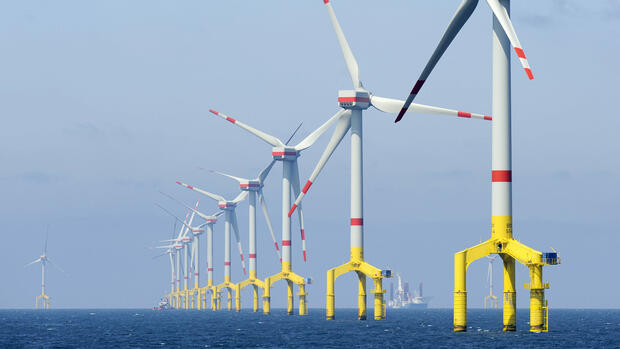Germany and the neighboring countries of the Netherlands, Denmark and Belgium have ambitious goals for the expansion of wind power at sea.
(Photo: dpa)
Munich, Berlin The power grid operator Tennet is continuing to expand the grid in the North Sea. On Thursday, the Dutch company commissioned the construction of three converter platforms to connect offshore wind farms in the North Sea to the grid. At the end of March, Tennet had already awarded eleven converter platform projects. The order volume for all 14 platforms amounts to 30 billion euros.
Tim Meyerjürgens, COO of Tennet, said that the construction of the converter platforms is “a big step forward in the development of the North Sea into Europe’s climate-neutral power plant”.
With the construction of the platforms, Tennet is taking account of the growing importance of offshore wind power. Germany, but also countries such as the Netherlands, Denmark and Belgium have set themselves ambitious goals for the expansion of wind power at sea. With the Esbjerg Declaration adopted in mid-May last year, the four countries committed to building at least 65 gigawatts (GW) of offshore wind energy by 2030.
A total of eight GW of offshore wind power is currently installed in the German North and Baltic Seas. But this is just the beginning. According to the coalition agreement, this should be at least 30 GW by 2030, at least 40 GW by 2035 and at least 70 GW by 2045.
With the 14 projects that are scheduled to be completed by the end of 2031, Tennet is also breaking new technical ground and setting a new standard together with its partners – including Siemens Energy, Hitachi Energy and GE.
Tennet is pursuing a new concept in converter platforms
So far, the connection of offshore wind farms has worked like this: The wind turbines produce alternating current, which is collected on the wind farm’s own transformer platforms and transformed to a voltage of 155 kilovolts (kV). The electricity is then forwarded from the substation to the converter platform of the transmission system operator.
>> Read here: The British are once again cooperating with the EU on the expansion of offshore wind power
The electricity from several wind farms is collected on the converter platform and converted from alternating current to direct current before being transported to the grid connection point on land. The transmission takes place by means of direct current in the voltage range of 320 kV.
Tennet is now pursuing a new concept: the transformer platform in the wind farm is no longer needed and the AC cables are fed directly into the offshore converter platform. There they are converted into direct current, and the electricity is transported ashore at the voltage level of 525 kV. At this voltage level, large amounts of electricity can be transmitted particularly efficiently.
The previous standard had a connection capacity of 0.9 GW, the new standard enables two GW. The new concept is to become the blueprint for future offshore grid connection systems. It should significantly accelerate the expansion of offshore wind energy because the number of platforms is falling and fewer cables need to be laid.
Largest order for Siemens Energy since the spin-off from the parent company
Siemens Energy is one of the key partners in developing the technology. The Tennet order is one of the largest since the spin-off from Siemens in 2020. In a consortium with the Spanish shipyard Dragados Offshore, the energy technology specialist is to supply the technology for three of the planned grid connections in the North Sea. The value of the contract for the partners is almost seven billion euros. In industry circles it is estimated that around half of this is attributable to Siemens Energy.
According to industry circles, the order amount will go equally to Siemens Energy and Dragados Offshore.
(Photo: Reuters)
As part of the BalWin3, LanWin2 and LanWin4 projects, the electricity from wind farms is to reach the connection points in Wilhelmshaven and in the Heide area. Siemens is contributing the main electrotechnical components such as switchgear, transformers and converter technology. Dragados is responsible for the construction and installation of the platforms.
In the initial phase of offshore wind farms, Siemens lost a lot of money with the platforms. In the meantime, however, Siemens Energy has standardized the production of the huge systems to a greater extent. The group is currently handling eleven grid connection projects for wind turbines in Germany, Great Britain and the USA. Five others have already been completed.
>> Read here: How to benefit Siemens Gamesa and RWE from the US boom in wind power
“In the global race against climate change, grid expansion must be able to keep up with the accelerated expansion targets for renewable energies,” said Siemens Energy board member Tim Holt. In order for the industry to be able to ramp up its capacities, “all levers must also be thrown at the political level – from strategies for raw materials and skilled workers to a further streamlining of the approval procedures at all levels”.
More: Tennet sees an investment requirement of 111 billion euros
